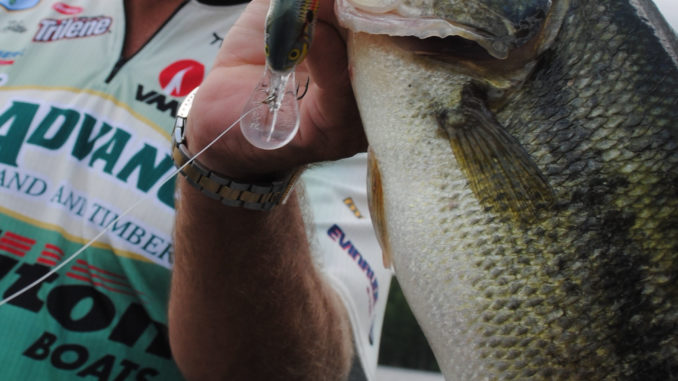
Diving baits are perfect for schooling bass
Like most bass fishermen, I like to fish shallow in the spring, and there’s no question that in March, April and May, the fishing is good, but you have to sort of grind it out and catch one here and one there for a good limit.
I really enjoy bass-fishing in June, when I’m targeting offshore schools of fish. I really like it. The bass are schooled up, and they’re feeding on shad or blueback herring for the most part. You find them on offshore spots like humps and points, and when you do find them, you can do real well in a hurry. You can catch a limit in five casts.
Most of these fish have come through the post-spawn period sometime in May, and they’re out, schooled up and hungry. The key is finding bait on one of these spots, and you can use your electronics to help.
I’ve got a lot of history on our lakes in South Carolina. I know a lot of little points and humps and ledges and where they are, but it’s still good to be able to ride over ’em and graph ’em, look at ’em on my Humminbird Side-Finder equipment. You can see if somebody has dropped a brush pile on it that wasn’t there before, and you can see where the bait is, what part of the spot the fish are relating to. Even though I’ve fished them for years, I like to take a look at a spot.
Most of these fish are going to be in about 10 to 15 feet of water this month. By July, they’ll start moving a little deeper, but the advice I’d give anyone is that you’ll catch most of your fish in all of our lakes in that depth range.I travel all over the country fishing, and water clarity and different types of fish and baitfish can affect the depth the hold, but for the most part, they’ll be in 10 to 15 feet of water.
I do my searching with a crankbait. I like Rapala’s DT series, the DT-10, DT-14 and DT-16, and I fish a Storm Arashi, which is a square-billed bait that will get down to about 10 feet. I think it’s critical to throw shad-type colors. I might throw a bait that has a little chartreuse on the back or belly, but it will be basically a shad-colored bait.
I search with a crankbait, and when I find them, I might catch ’em all on a crankbait, but if it slows down, I’ll throw a Mop Jig or a Texas-rigged Trigger-X Hammer worm to try and catch a bigger fish. Once in a while, if I’m convinced there’s a school of fish on a spot, I might go there first thing in the morning and fish a Mop Jig right away and try to catch a big fish first.
Anyway, I will go searching with a crankbait, and when I find fish, if I catch ’em every cast, I’ll keep catching ’em on a crankbait. If you’ve got a school of 3- and 4-pound fish and they’re hitting the crankbait, just keep at it. I’ll catch as many as I can on a crankbait, then I’ll fish a Mop Jig. But if it slows down, I’ll throw the Mop Jig or Hammer worm. A lot of times, the bigger fish might not be as aggressive.
I choose colors for the Mop Jig and Hammer worm based on what the water clarity is. If I’m fishing up the river at a lake like Wateree or Murray where the water is most likely going to be a little stained, I’ll fish colors like junebug and red shad. If I’m on the lower, clearer end of a lake, I’ll go with watermelons and green pumpkin.
Crankbaits are great tools when fish are ganged up. You can often find an entire school that’s aggressive if they’re around bait, and the results will be amazing. They do, however, require a little different equipment than a jig or spinnerbait. You need a rod with a little give, and there’s where rods that are specifically made for crankbait fishing come in. I fish crankbaits on a 7-foot, medium-action All-Star cranking rod with a Pfleuger Patriarch reel that’s spooled with 10-pound Trilene 100-Percent Fluorocarbon. You want to fish relatively light line so you get the most action out of your bait, and the fluorocarbon has no stretch — it’s a great match for a cranking rod that’s a little softer.
So tie on a crankbait, tune in your electronics and head for those spots where bass go when they leave the areas where they’ve spawned. June is a tremendous month to catch a nice bag of fish without ever moving your boat.




Be the first to comment